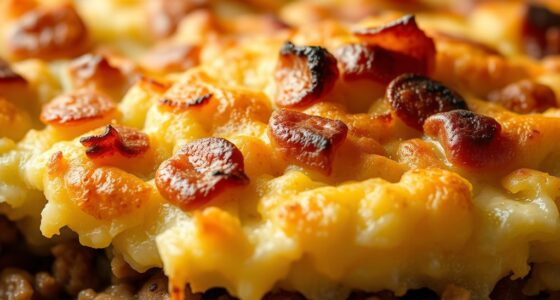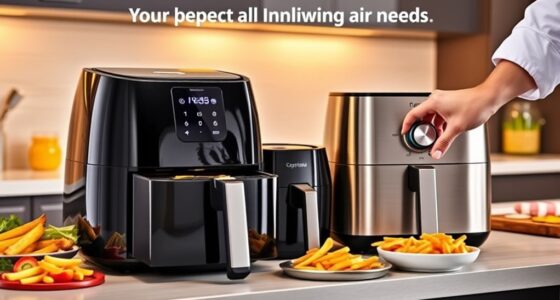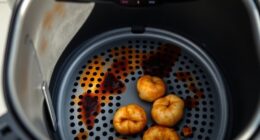When converting oven recipes to an air fryer, reduce the oven temperature by about 25°F to 30°F for best results. For example, if a recipe calls for 375°F in the oven, set your air fryer to around 350°F. Keep in mind, air fryers cook faster, so check your food earlier and adjust cooking times accordingly. For more tips on perfect conversions, continue exploring ways to get crispy, delicious results.
Key Takeaways
- Reduce oven temperatures by about 25°F to 30°F when converting to an air fryer.
- For example, 350°F in oven equals roughly 320°F in the air fryer.
- Always preheat the air fryer for even cooking and better results.
- Adjust cooking times downward by 20-25% compared to oven times.
- Monitor food closely during initial conversions to prevent over or undercooking.
Understanding the Basics of Air Fryer Temperatures

Understanding the basics of air fryer temperatures is essential for achieving perfect results. Your air fryer cooks by circulating hot air rapidly around food, making the temperature setting vital. Typically, air fryers operate within a range of 180°F to 400°F (82°C to 204°C). Unlike ovens, they heat up quickly and maintain precise temperatures, giving you more control over cooking. When you set the temperature, you’re dictating how hot the air gets, which directly influences cooking speed and texture. Lower temperatures are ideal for delicate foods or slow cooking, while higher temperatures crisp up foods fast. Familiarizing yourself with these basics helps you adjust recipes accurately and avoid under or overcooking. Proper temperature understanding guarantees your dishes turn out crispy, tender, and evenly cooked every time. Incorporating professional equipment for recording or following recipes can further enhance your results. Additionally, understanding the temperature range helps you select the appropriate settings for different recipes and ingredients. Knowing the temperature control capabilities of your device can also lead to more consistent cooking outcomes. Recognizing how air circulation impacts heat distribution can help optimize cooking efficiency and food quality.
How to Convert Oven Temperatures to Air Fryer Settings

Converting oven temperatures to air fryer settings is straightforward once you know the general guidelines. Usually, you’ll reduce the oven temperature by about 25°F to 30°F when switching to an air fryer. Here’s a quick reference:
- For 350°F in the oven, set the air fryer to 320°F.
- For 375°F, use 350°F in the air fryer.
- For 400°F, lower it to 375°F.
- For 425°F, set the air fryer to 400°F.
Keep in mind, air fryers cook faster and hotter, so start with these adjustments and monitor your food. It’s a good idea to check regularly the first few times you convert recipes. Additionally, understanding the temperature accuracy of your air fryer can help ensure better results. When adjusting recipes, consider cooking time variations since air fryers often require less time than traditional ovens. Proper air circulation is also crucial for even cooking, so avoid overcrowding the basket. Knowing how essential oils work with heat can help prevent degradation of their beneficial properties during cooking or preparation.
Adjusting Cooking Times When Switching to Air Fryer

When you switch from an oven to an air fryer, you’ll often need to modify your cooking times because air fryers cook more quickly and efficiently. Typically, you should reduce the original oven cooking time by about 20-25%. For example, if a recipe calls for 30 minutes in the oven, check the food around 22-24 minutes in the air fryer. Keep an eye on your food to prevent overcooking, especially during the last few minutes. It’s helpful to shake or rotate items halfway through cooking to ensure even crispness. Remember, smaller quantities tend to cook faster, so adjust time accordingly if you’re cooking in batches. Using the appropriate cooking techniques can help you achieve the perfect crispy, delicious results every time. Additionally, understanding asset division laws can be beneficial if you’re planning for future financial stability after your cooking endeavors. Proper temperature adjustment is essential to avoid undercooking or burning your food. Familiarizing yourself with air fryer models and their specific capacities can also make your cooking more precise and efficient. With a little practice, you’ll find the perfect timing to get crispy, delicious results every time.
Common Temperature Conversion Charts and Guidelines

To guarantee your recipes turn out perfectly when switching between oven and air fryer, it’s essential to familiarize yourself with common temperature conversion charts and guidelines. These charts help you adjust cooking temperatures accurately, ensuring even results. Here are some key points to keep in mind:
- A typical oven temperature of 350°F usually converts to about 325°F in an air fryer.
- For 400°F oven settings, set your air fryer to around 375°F.
- Lower temperatures like 325°F in the oven often translate to 300°F in the air fryer.
- When in doubt, reduce the oven temperature by 25°F to 30°F for air fryer use, and monitor your food closely.
- Also, consider the air circulation and design of the air fryer, which can impact cooking times and temperature adjustments. Additionally, understanding the difference in heat distribution between the two appliances can help you fine-tune cooking times for optimal results.
- Recognizing cooking time variations based on the appliance type can further enhance your meal prep and avoid overcooking or undercooking.
- Remember that nutritional differences between methods can influence cooking adjustments, as some nutrients may degrade at higher temperatures or shorter cooking times.
Having these conversions handy simplifies the process and helps you avoid over- or undercooking.
Tips for Perfect Results During the Transition

Switching from oven to air fryer can be straightforward if you follow a few key tips to guarantee perfect results. First, always preheat the air fryer to ensure even cooking, just like you would with an oven. Reduce the cooking time by about 20-25%, since air fryers cook faster due to their rapid air circulation. Keep an eye on your food during the first attempt, adjusting time and temperature as needed. Use light coatings of oil or cooking spray to achieve crispiness without excess fat. Avoid overcrowding the basket, which can lead to uneven cooking. Finally, flip or shake your food halfway through cooking to promote uniform browning. With these tips, you’ll master the transition and enjoy delicious, perfectly cooked meals. Additionally, understanding market dynamics can help you better plan your cooking schedule and avoid overcooking or undercooking. Being aware of organic and natural juices can inspire you to incorporate healthier ingredients into your recipes for enhanced flavor and nutrition. Moreover, experimenting with different water park-themed recipes can make your meals more fun and engaging. To optimize your results, consider the importance of temperature control in achieving consistent doneness, especially when transitioning recipes from oven to air fryer.
Frequently Asked Questions
Can I Use the Same Recipes for Convection Ovens and Air Fryers?
You might wonder if you can use the same recipes for convection ovens and air fryers. While both appliances circulate hot air, air fryers cook faster and often require lower temperatures. To avoid burning or uneven cooking, reduce the recipe’s temperature by about 25°F and check your food earlier. Keep an eye on your dish and adjust cook times accordingly for the best results.
Are There Foods That Shouldn’T Be Cooked in an Air Fryer?
You might wonder if any foods are unsuitable for your air fryer. Generally, avoid cooking foods with wet batters, like tempura or funnel cakes, because they can create a mess and damage the appliance. Also, large or irregularly shaped items may not cook evenly. Be cautious with delicate items like leafy greens or foods that might fly around easily. Always check recipes and manufacturer guidelines to keep your air fryer safe and effective.
How Do Altitude Changes Affect Temperature Conversions?
Altitude changes can considerably impact temperature conversions when cooking with an air fryer. At higher elevations, the boiling point drops, which means you might need to increase cooking times or adjust temperatures slightly to guarantee your food cooks thoroughly. You should monitor your dishes closely and make small adjustments as needed. Experimenting with recipes helps you find the right settings, ensuring your meals turn out perfectly no matter the altitude.
What Safety Precautions Should I Follow When Adjusting Temperatures?
Imagine your kitchen as a safe harbor where you’re adjusting your cooking settings. When changing temperatures, always double-check your recipes and use a reliable thermometer to avoid surprises. Keep an eye on food to prevent burning or undercooking. Use oven mitts to handle hot equipment, and guarantee proper ventilation. These precautions help you cook safely, giving peace of mind with every adjustment you make.
Do Different Brands of Air Fryers Require Different Temperature Settings?
Different brands of air fryers might have slight variations in how they heat and display temperatures. You should always verify your specific air fryer’s manual, as some models may run hotter or cooler than others. While basic temperature settings are similar, it’s a good idea to start with recommended temps and adjust as needed based on your appliance’s performance. This helps ensure your food cooks evenly and safely.
Conclusion
Remember, when converting oven recipes to your air fryer, precision matters, but don’t overthink it. Start with recommended temperature adjustments and keep an eye on your food. As the saying goes, “Practice makes perfect,” so don’t be discouraged if your first attempt isn’t flawless. With a little patience and experimentation, you’ll master the shift and enjoy delicious results every time!









